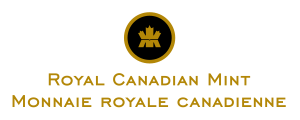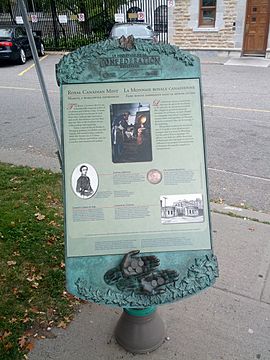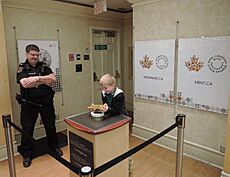Royal Canadian Mint facts for kids
- Royal Canadian Mint
- Monnaie royale canadienne
Quick facts for kids  |
|
| Crown corporation | |
| Industry | Coin mintage |
| Founded | January 2, 1908 |
| Headquarters | Ottawa, Ontario, Canada |
|
Number of locations
|
2 |
|
Area served
|
Worldwide |
|
Key people
|
Marie Lemay (master of the mint & CEO) |
| Products | Coins |
| Services | Precious metal storage, assay, refinery and coin production |
| Revenue | |
|
Operating income
|
|
| Total assets | |
| Total equity | |
|
Number of employees
|
1,189 (2022) |
The Royal Canadian Mint (also known as Monnaie royale canadienne in French) is where Canada's coins are made. It's a special type of company owned by the Canadian government, called a Crown corporation. The Mint follows rules set by a law called the Royal Canadian Mint Act.
The Mint makes all the coins you use in Canada every day. It also makes coins for other countries around the world! Besides regular coins, the Mint creates special collector coins from precious metals like gold and silver. They also make medals and tokens. The Mint even helps refine (clean) gold and silver.
The Mint works for the public good, but it also needs to make a profit. This means it runs like a business and doesn't rely on taxpayer money to operate. It has a group of leaders called a board of directors who help guide the company.
Contents
How the Mint Started
For about 50 years, Canada's coins were made far away in London, England, at the Royal Mint. Some were even made at a private mint in Birmingham, England. As Canada grew, it needed more and more coins. So, in 1890, people started talking about building a branch of the Royal Mint right here in Ottawa. This idea was approved in 1901.
Opening the Ottawa Mint
The Ottawa branch of the Royal Mint officially opened on January 2, 1908. During a small ceremony, Lord Grey and Lady Grey started the coin presses. The very first coin made was a 50-cent coin. When it first opened, 61 people worked there.
A few years later, the Mint started cleaning gold using a process called electrolysis. In 1915, they found an even faster way to clean gold using a chlorination process. This helped the Mint clean more gold much quicker.
Becoming the Royal Canadian Mint
In 1931, Canada became more independent from the British Empire. The Mint's ownership was then given to the Canadian government. In December 1931, it officially became the Royal Canadian Mint. It started working as a part of the Department of Finance.
Expanding to Winnipeg
By 1960, the Ottawa Mint was getting very busy. Many Canadian 10-cent coins were even being made in the United States! So, in 1968, a study showed that the Ottawa building was getting old. Money was set aside for a new building, but no good spot was found in Ottawa.
In April 1969, the Royal Canadian Mint became a Crown corporation. This meant it could make its own decisions and had its own board of directors. It was no longer just a part of the Department of Finance.
In February 1970, it was suggested that the new Mint facility be built in Winnipeg. This was a big discussion because Winnipeg is very far from Ottawa. However, a study showed it was a good idea because raw materials could be bought from a supplier in Alberta, which was closer. In December 1971, everyone agreed to build the new Mint in Winnipeg. Construction started in 1972, and the Winnipeg facility officially opened in 1976.
Saying Goodbye to the Penny
In March 2012, the Canadian government decided to stop making pennies. The very last penny was made at the Mint's Winnipeg factory on May 4, 2012.
How the Mint Works
The leader of the Royal Canadian Mint is called the Master of the Mint. Since 2018, Marie Lemay has held this important job. The Mint's leaders report to the Minister of Finance.
The Mint was even named one of "Canada's Top 100 Employers" for several years!
Mint Leadership
The Royal Canadian Mint is a Crown corporation, which means it has more freedom to manage itself than other government groups. It runs like a business. It has a board of directors, including a chairman, the president (who is also the CEO), and eight other directors.
The president and CEO is also known as the Master of the Mint. Marie Lemay is the current president, appointed in 2019. The chairman of the board is Phyllis Clark.
The Department of Finance is the government department that works with the Royal Canadian Mint. The Mint has four main areas of business: making gold and silver products, making Canadian circulation coins, making coins for other countries, and making special collector coins.
Mint Buildings
Ottawa Facility
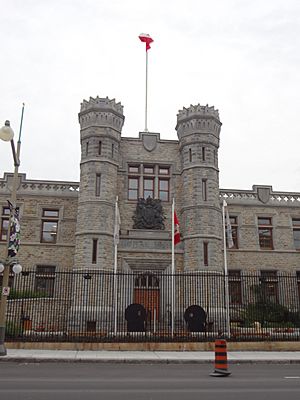
The Ottawa Mint building opened on January 2, 1908. It started with 61 employees. The last original staff member, Owen Toller, worked there for 45 years! He retired in 1953 and lived to be 102 years old.
In 1979, the Royal Canadian Mint building in Ottawa was named a National Historic Site. This was because of its special Tudor-Gothic style, which helped create a unique look for Canada's capital. It also marked the time Canada took control of its own money from Britain.
Winnipeg Facility
| Winnipeg Royal Canadian Mint | |
|---|---|
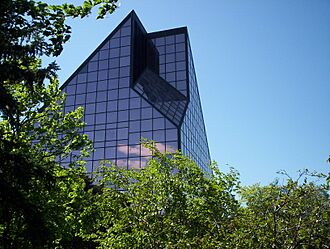 |
|
| General information | |
| Type | Low-rise |
| Architectural style | Modernist |
| Location | 520 Lagimodière Boulevard, Winnipeg, Manitoba R2J 3E7 |
| Coordinates | 49°51′21″N 97°03′13″W / 49.855915°N 97.05348°W |
| Construction started | 1972 |
| Opened | 1976 |
| Cost | $16 m CAD |
| Owner | Royal Canadian Mint |
| Height | 10.11 metres (33.2 ft) |
| Technical details | |
| Structural system | Rigid frame |
| Material | steel |
| Floor count | 3 + basement |
| Design and construction | |
| Architect | Étienne Gaboury |
| Architecture firm | Gaboury Lussier Sigurdson with Number Ten Architectural Group |
The Mint's building in Winnipeg opened in 1976. It looks very different from the Ottawa building. Architect Étienne Gaboury designed a unique triangular building that stands out in the flat prairie landscape.
The Winnipeg facility makes all the regular coins for Canada and other countries. The Ottawa facility focuses on making special collector coins.
Keeping the Mint Safe
The Royal Canadian Mint has its own security team called Protective Services. These officers work full-time and part-time to keep the Mint's buildings safe. They wear black uniforms and carry special equipment. Their jobs include:
- Checking things with X-ray machines.
- Watching security cameras.
- Controlling who enters and leaves the buildings.
- Making sure shipments are safe.
- Helping with emergency evacuations.
Special Marks on Coins
Coins sometimes have small marks called "mint marks" or "privy marks." These marks can tell you where or when a coin was made, or even why it was made. Here are a few examples:
- C – Used on gold coins made in Ottawa between 1908 and 1919.
- Dot – In 1937, some coins had a small dot under the year 1936. This showed they were actually made in 1937, while new designs were being prepared.
- H – Used on coins made for Canada by the Heaton Mint in England before 1907.
- Innukshuk – All coins for the 2010 Vancouver Olympics have this mark.
- Maple Leaf – Coins made in 1948 had a small maple leaf mark. This was because of a delay in getting new coin designs, so they used the 1947 date with a maple leaf to show they were made in 1948.
- P – From 2001 to 2006, many Canadian coins had a "P" mark. This showed they were made using the Mint's special plating process.
- RCM Logo – Since 2006, the Mint has used its own logo as a mark on coins. This helps people know that the Royal Canadian Mint made the coin.
- W – Sometimes used on special coin sets made in Winnipeg since 1998.
- WP – Used on a special set of coins in 2003. "W" means Winnipeg, and "P" means plated.
What the Mint Makes
The Royal Canadian Mint is known for many "firsts" in the world of coins!
- It made the first colored coin in 1999.
- It made the first coin with a hologram in 1999.
- It made the first oddly shaped coin (a square silver beaver) in 2006.
- It made the first 5-ounce pure silver coin in 2006.
- It made the first coin with glass added to it in 2017.
- It made the first glow-in-the-dark coin for circulation in 2017.
- It made the first million-dollar face-value coin, which was a huge 100 kg pure gold coin!
Cool Coin Technologies
Multi-Ply Plating
In 2000, the Mint created a new way to make coins called multi-ply plating. This method uses a steel core covered with thin layers of nickel and copper. This makes coins stronger and cheaper to produce. It also helps prevent fake coins because each coin has a unique electromagnetic signal. Since 2012, all Canadian $1 and $2 coins use this technology.
Coloured Coins
In 2004, the Royal Canadian Mint made the world's first colored coin for everyday use. It was a 25-cent coin with a red poppy design. About 30 million of these coins were put into circulation.
In 2006, the Mint made another colored 25-cent coin with a pink ribbon to support breast cancer awareness. They also made more poppy coins in 2008 and 2010. The Mint even made colored coins for Papua New Guinea in 2008, which were the first colored coins to circulate outside of Canada!
Glow-in-the-Dark Coins
In 2017, for Canada's 150th birthday, the Mint released a special $2 coin. This coin had a picture of the Northern Lights that glowed turquoise in the dark! It was the first glow-in-the-dark coin ever made for general use. About ten million of these coins were made.
The Mint also made glow-in-the-dark collector coins before this, like a set of dinosaur skeletons in 2012. More recently, they made glow-in-the-dark coins about UFO sightings in Canada and a special flying fish coin for Barbados.
Mintshield
In 2018, the Mint created "Mintshield" technology for its silver coins. This helps stop "milk spots," which are white spots that can appear on silver coins. The Royal Canadian Mint is the only mint that offers this special technology.
Bullion Products and Refinery
The Mint makes and sells very pure gold, silver, palladium, and platinum coins, bars, and wafers for people who want to invest in precious metals. They also provide services to clean and store these metals.
The Mint has a very advanced refinery that cleans raw gold to be 99.99% pure. They even made the world's first 99.999% pure gold coins in 2007!
Maple Leaf Bullion Coins
The Mint started making its own special bullion coins in 1979, featuring a maple leaf design.
- Gold Maple Leaf (GML) coins are known for their very high purity. They come in different sizes, from 1 ounce down to very small fractions of an ounce.
- Silver Maple Leaf (SML) coins were first made in 1988 with the same maple leaf design. They also come in different sizes. The Mint has also made special SML coins with wildlife designs, colors, and holograms.
- Platinum and Palladium Maple Leaf coins have also been made in limited numbers for collectors and investors.
Canadian Circulation Coins
The Mint's main job is to make and distribute Canada's everyday coins. They also create new coin designs to celebrate Canada's history and culture. The Winnipeg facility makes up to two billion Canadian coins each year! While the Queen's image has been on every Canadian coin since 1908, the designs on the back of the coins have changed a lot.
V Nickel
During World War II, metals like copper and nickel were needed for the war. So, the 5-cent coin was changed to a different metal and had a "V for Victory" design in 1943. This coin even had a secret message in Morse code around its edge that meant "We Win When We Work Willingly."
Canada's 100th Birthday Coins
In 1967, to celebrate Canada's 100th birthday, the Mint made a special series of coins. Each coin featured a different Canadian animal: a dove, a rabbit, a mackerel, a lynx, a wolf, and a Canada goose.
Royal Canadian Mounted Police Coins
In 1973, the 25-cent coin featured a Royal Canadian Mounted Police officer on a horse. This celebrated 100 years of the RCMP. The Mint has also made special gold coins featuring the RCMP.
"Loonie" and "Toonie"
A big change for Canadian coins happened in the 1980s with the introduction of the $1 coin. It's called the "loonie" because it has a common loon bird on it. This coin started to replace the $1 paper bill in 1989.
In 1996, the Mint introduced the $2 coin, known as the "toonie." It has a polar bear on it and replaced the $2 paper bill. The toonie was also special because it was the first Canadian coin made of two different metals, with a bronze-colored center and a nickel-colored outer ring.
Saskatchewan Roughriders Coin
In September 2010, the Mint released 3 million special $1 coins to celebrate 100 years of the Saskatchewan Roughriders football team. This coin had the team's logo and the number "100" on it.
Coins for Other Countries
The Royal Canadian Mint makes coins for many other countries around the world! They make regular coins, collector coins, and even blank coins that other countries can stamp themselves.
In 1970, the Mint started making coins for other countries again, after a long break. They made coins for Singapore, Brazil, Yemen, and Iceland. Since then, they have made coins for many nations, including Jamaica, the Bahamas, Bermuda, Iran, New Zealand, and Papua New Guinea.
In 2008, the Mint made over 3 million colored 50-toea coins for Papua New Guinea. These were the first colored coins to be used in daily life outside of Canada!
Special Collector Coins
The Mint makes many beautiful collector coins for people who love coins. These coins often use special technologies like holograms, enamel, lasers, and even embedded crystals. Many of these coins have won international awards!
Olympic Medals and Coins
The Mint has a long history of making medals for big sporting events. They made the athlete medals for the 1976 Montreal Olympic Games and the 2010 Vancouver Olympic and Paralympic Winter Games. For the 2010 Games, they made 615 Olympic and 399 Paralympic medals at their Ottawa headquarters. They also made 4,283 medals for the 2015 Pan Am and Parapan Am games in Toronto.
In 2006, the Mint partnered with the Vancouver Olympic Committee. They created a three-year program of special coins to celebrate the 2010 Winter Games. This included 17 different coins for circulation, like 25-cent coins and $1 "lucky loonies." The Mint was the first in the world to put the Paralympic Games on a coin for everyday use.
The Mint also made a series of 36 collector coins for the Vancouver Games, including very large 1-kilogram pure gold coins.
The medals for the 2010 Winter Games were very special. Each gold medal was sterling silver covered with 24-karat gold. The silver medals were sterling silver, and the bronze medals were mostly copper. Each medal had a unique part of an artwork by a Canadian artist named Corrine Hunt. The medals were also wavy, not flat, and had to be stamped nine times to get their unusual shape!
Award-Winning Coins
The Royal Canadian Mint has won many awards for its amazing coins over the years. Here are just a few:
- 1985 – Coin of the Year for the 1988 Olympic $20 coin (Downhill Skier).
- 1986 – Best Gold Coin for the 450th Anniversary of Jacques Cartier's Voyage.
- 1988 – Best Silver Coin for the 400th Anniversary of Davis Passage.
- 1994 – Best Coin for the "Anne of Green Gables" coin.
- 1998 – Most Popular Coin for the $2 coin with the polar bear design.
- 2006 – Most Innovative Coin of the Year for the Coloured 25-cent Poppy Coin.
- 2007 – Best New Coin Award for the 25-cent colored breast cancer awareness coin.
- 2010 – Best New Series for the Vancouver 2010 Circulation Coin Programme.
- 2011 – Best Silver Coin for the 2009 Fine Silver Crystal Snowflake.
Images for kids


